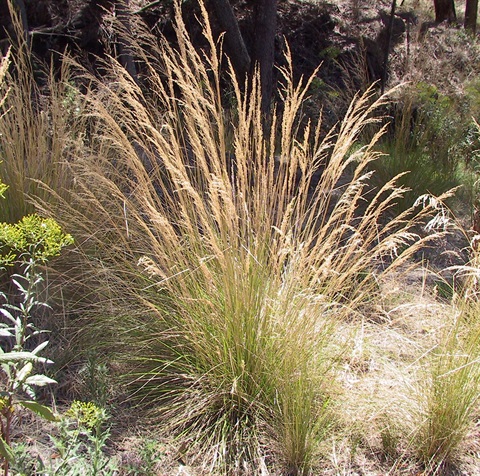
Poa labillardierei var. labillardierei
Common Tussock-grass
Large, coarse, densely tufted perennial. Flowering stems rounded, erect.
Additional information
- FamilyPoaceae
- StoreyLower storey
- Size0.3-0.8 cm high, stems to 1.3 m high
- Plant groupingGrasses, Rushes & Sedges
- LeavesRough, folded, if inrolled then loosely, green to greyish-green leaves, to 80 cm x 3.5 mm, tips sometimes ending in a prickly point. Sheath pale.
- Flower colourGreen or purplish
- Flowering timeOctober to February
- FlowersOpen pyramidal flowerhead, to 25 cm x 15 cm, 3-5-flowered spikelets; lower bracts 3-veined, lower floral bract very narrow, 5-veined, hairy on lower part of keel and outer veins only, webby basal hairs.
- Bird attractingSeeds, habitat - nesting materials
- Butterfly attractingFood plant for caterpillars
- Frog habitatYes
- Growing conditionsMoist alluvial soils along watercourses and on flats. Frost tolerant. Full sun, semi shade.
- Garden useA vigorous and tolerant grass that is commonly used in landscaping. Adds vertical interest. Plant in drifts. Dead leaves can be removed using a soft rake.
- Commercially availableGenerally. Specialist grass suppliers
- Conservation statusWidespread within the Shire
- Aboriginal Use Leaves - string and basket-making
- Related speciesP. labillardierei is sometimes confused with Poa sieberiana and some of the drier communities listed may be misidentifications. The latter is smaller with fine, often curled, inrolled to round leaves. The lower floral bract has short hairs between the veins as well as on them, and has either a poor or no web at the base.
Photo Gallery
Photographer/s: 1 Russell Best, NatureShare ©; 2 Marilyn Bull ©; 3-5 Peter Kinchington ©
Plant Communities